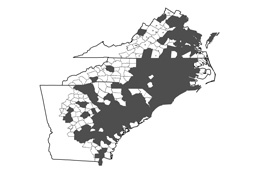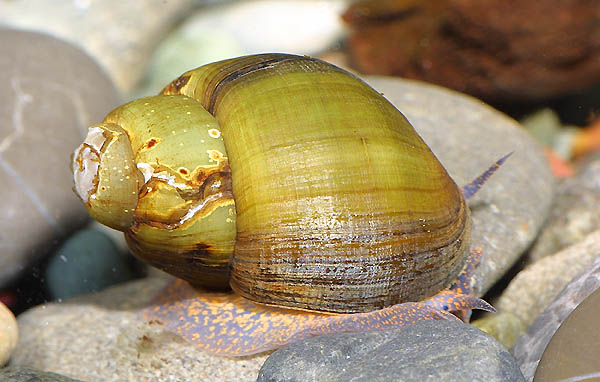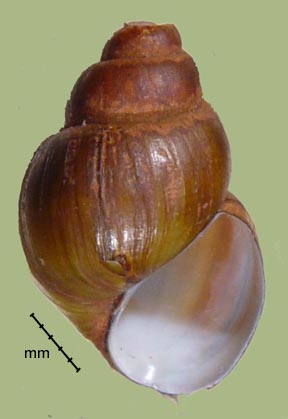> Habitat & Distribution
 Combined with all its probable synonyms, Campeloma decisum ranges throughout eastern North America, well up into Canada and down to Florida. It is widespread throughout the southeastern United States, burrowing in the sandy bottoms of rivers where the current is sufficient to oxygenate the water column. Campeloma is not commonly found in lentic environments in the southeast.
Combined with all its probable synonyms, Campeloma decisum ranges throughout eastern North America, well up into Canada and down to Florida. It is widespread throughout the southeastern United States, burrowing in the sandy bottoms of rivers where the current is sufficient to oxygenate the water column. Campeloma is not commonly found in lentic environments in the southeast.
> Ecology & Life History
Little is known regarding the diet of Campeloma. The burrowing habit and peculiar radular morphology displayed by these snails imply an ability to filter feed, as has been documented for Viviparus. But the snails have almost certainly retained the ability to graze or harvest deposits on soft sediments as well. There are reports that Campeloma can be baited with carrion.
Parthenogenesis has evolved three times in freshwater gastropods, all three occasions (Campeloma, Potamopyrgus, and the thiarids) in ovoviviparous brooders (Dillon 2000:109). Some populations of Campeloma appear comprised entirely of parthenogenic females, others appear to reproduce entirely by outcrossing, and some populations display a mixture of the two modes (Johnson & Bragg 1999, Johnson & Leefe 1999, Johnson 2000, Crummett & Wayne 2009). Only one year is required for maturation in some populations, two in others, and both semelparous and iteroparous reproduction have been reported (Vail 1978, Brown et al. 1989, Brown & Richardson 1992).
> Taxonomy & Systematics
The first species of American Campeloma to reach description was decisum, authored by Thomas Say from his collections in the Delaware River. A great many nomena were added in the 19th and early 20th century, boiled down to 14 by Clench (1962) and further reduced to 8 by Burch.
The widespread occurrence of parthenogenesis in this group voids the biological species concept and necessitates a retreat to the morphological. In his extensive survey of genetic divergence among southern Campeloma populations, S. G. Johnson has applied five nomina: decisum, limum, floridense, geniculum and parthenum. Burch’s key distinguishes floridense by an aperture color darker than any seen in South Carolina. But the other four taxa are separable only by weak and variable traits, geniculum bearing a “broadly ovate” shell with angled shoulders and limum a “narrowly ovate” shell with angled shoulders, while decisum and parthenum both bear “rounded” shoulders and are distinguishable by geography alone. Johnson has personally communicated to me his feeling that no consistent or reliable difference exists among these nominal taxa. Thus all populations in Atlantic drainages of the southeast are referred to the oldest available nomen, C. decisum.
Synonyms include Campeloma coarctatum, Campeloma crassulum, Campeloma decisa, Campeloma exilis, Campeloma integra, Campeloma integrum, Campeloma milesi, Campeloma milesii, Campeloma obesum, Campeloma ponderosum, Campeloma regulare, Campeloma rufum, Campeloma subsolida, Campeloma subsolidum, Campeloma subsolidus, Melantho decisa, Melantho integra, Melantho nolani, Melantho ponderosa, Melantho subsolida, Paludina decisa, Paludina integra, Paludina ponderosa, Paludina regularis, Vivipara decisa, Vivipara ponderosa, and Vivipara subsolida.
> Supplementary Maps and Resources [PDF]
- North Carolina
- South Carolina
- Georgia
- Species Account (VDGIF)
- Pretty photo of living Campeloma decisum, courtesy of Chris Lukhaup.

> References
Brown, K.M. & Richardson, T. D. (1992) Phenotypic plasticity in the life histories and production of two warm-temperature viviparid prosobranchs. Veliger 35: 1-11.
Brown, K. M., Varza, D.& Richardson, T. D. (1989) Life histories and population dynamics of two subtropical snails (Prosobranchia:Viviparidae). J. N. Am. Benthol. Soc. 8: 222-228.
Clench, W. (1962) A catalogue of the Viviparidae of North America with notes on the distribution of Viviparus georgianus, Lea. Occas. Pprs. on Mollusks, Mus. Comp. Zool. Harvard, 2, 261-87
. Clench, W. & Fuller, S. (1965) The genus Viviparus in North America. Occas. Pprs. on Mollusks, Mus. Comp. Zool. Harvard, 2, 385-412.
Crummett, L. T. & M. L. Wayne (2009) Comparing fecundity in parthenogenetic versus sexual populatons of the freshwater snail Campeloma limum: is there a two-fold cost of sex? Invert. Biol. 128: 1 - 8.
Harvey, M., Vincent, B., & Vaillancourt, G. (1983) (Development and fecundity of Campeloma decisum (Say) (Gastropoda: Prosobranchia) in a cold climate.) Naturaliste Canadien 110: 335-342.
Imlay, M. J., Arthur, J.W., Halligan, B.J., & Steinmetz, J.H. (1981) Life Cycle of the Freshwater Snail Campeloma decisum (Viviparidae) in the Laboratory. Nautilus 95: 84-88.
Johnson, S. G. (1992) Spontaneous and hybrid origins of parthenogenesis in Campeloma decisum (freshwater prosobranch snail). Heredity 68: 253-261.
Johnson, S.G. & Bragg, E (1999) Clonal diversity and polyphyletic origins of hybrid and spontaneous parthenogenetic Campeloma (Gastropoda: Viviparidae) from the southeastern United States. Evolution 53: 1769-1781.
Johnson, S. G. & Leefe, W. R. (1999) Evolution and ecological correlates of uniparental reproduction in freshwater snails. J. Evol. Biol. 12: 1056-1068.
Johnson, S.G., Lively, C.M. & Schrag, S.J. (1995) Age and polyphyletic origins of hybrid and spontaneous parthenogenetic Campeloma (Gastropoda: Viviparidae) from the southeastern United States. Experientia (Basel) 51: 498-509.
Karlin, A.A., Vail, V.A. & Heard, W.H. (1980) Parthenogenesis and biochemical variation in southeastern Campeloma geniculum (Gastropoda: Viviparidae). Malacol. Rev., 13: 7-15.
Richardson, T.D. & Brown, K.M. (1989) Secondary production of two subtropical snails (Prosobranchia:Viviparidae). J. N. Am. Benthol. Soc. 8: 229-236.
Vail, V.A. (1977) Comparative reproductive anatomy of 3 viviparid gastropods. Malacologia 16: 519-520.
Vail, V.A. (1978) Seasonal reproductive patterns in 3 viviparid gastropods. Malacologia 17: 73-97.








